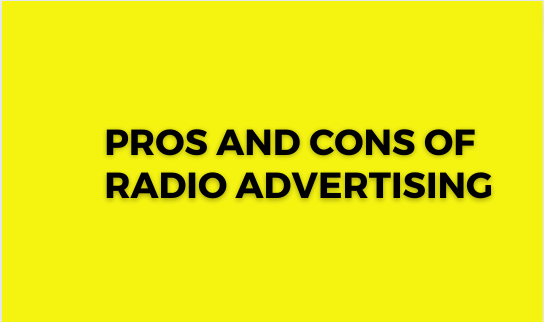Radio advertising is a form of audio advertising that aims to reach a specific target audience within a geographic area or a particular radio station’s listener-ship. Radio advertising can be an effective marketing strategy, but it also has its own set of advantages and disadvantages. Here are 40 pros and cons of radio advertising:
Pros:
- Wide audience reach: Radio advertising reaches a broad audience, including those who listen during their commute or at work.
- Local targeting: Radio allows for targeting specific geographic regions, reaching local consumers effectively.
- Cost-effective: Compared to other advertising mediums, radio advertising can be relatively affordable.
- Frequency and repetition: Frequent radio ads can help reinforce brand awareness among listeners.
- Quick production and turnaround: Radio ads can be produced and aired quickly, allowing for timely marketing campaigns.
- High frequency of ad exposure: Listeners are exposed to radio ads multiple times throughout the day, increasing brand recall.
- Immediacy of impact: Radio ads have the potential to generate immediate responses and drive instant traffic.
- Flexibility in ad formats: Radio ads can be customized into various formats, such as jingles, testimonials, or storytelling.
- Audio engagement: Radio engages the audience through audio content, leveraging the power of voice and sound.
- Emotional connection: Well-crafted radio ads can evoke emotions and connect with listeners on a personal level.
- Demographic targeting: Radio stations often cater to specific demographics, allowing for targeted advertising.
- Niche market reach: Specialized radio stations offer access to niche markets and specific interest groups.
- Complementary to other advertising channels: Radio advertising can complement other marketing channels, creating a cohesive campaign.
- Local celebrity endorsements: Collaborating with local radio personalities or celebrities can boost brand credibility and recognition.
- Increased brand awareness: Consistent radio advertising can help increase brand visibility and awareness.
- Mobile reach: Radio can reach mobile listeners, including those using smartphones or portable devices.
- Less intrusive than visual ads: Radio ads do not interrupt visual content and are less intrusive than other forms of advertising.
- Time efficiency: Radio ads can convey the message quickly, making an impact within a short duration.
- Targeting specific time slots: Advertisers can choose prime time slots when their target audience is most likely to be tuned in.
- Tracking audience response: Call-to-action elements in radio ads can be tracked to measure response and effectiveness.
Cons:
- Lack of visual component: Radio ads lack a visual element, limiting their ability to convey complex visuals or product demonstrations.
- Limited audience targeting: Radio ads have a less precise targeting capability compared to digital advertising, making it harder to reach specific demographics.
- Inability to control listener attention: Listeners may be engaged in other activities or distractions, reducing their attention to radio ads.
- Short ad exposure time: Radio ads typically have a short duration, making it challenging to convey a comprehensive message.
- Lack of audience retention: Unlike print or digital ads, radio ads cannot be revisited, reducing long-term brand exposure.
- Intangible results: Measuring the direct impact and ROI of radio advertising can be difficult.
- Competition with other audio content: Listeners may switch stations or tune out during ad breaks, reducing the reach of radio ads.
- Lack of visual branding opportunities: Radio ads do not provide visual branding elements, limiting brand recognition and recall.
- Inability to target specific interests: Unlike digital platforms, radio ads cannot be targeted based on specific interests or online behaviors.
- Limited tracking capabilities: Tracking listener response and conversion rates from radio ads is more challenging compared to digital advertising.
- No precise geographical targeting: Radio ads cover a general geographic region, making it harder to target specific localities.
- Lack of interactivity: Radio ads do not offer interactive elements or direct engagement with the audience.
- Background noise interference: External noises or distractions may compete with radio ads, reducing their effectiveness.
- Ad clutter: Ad breaks on radio can be cluttered, leading to ad fatigue and reduced impact.
- Limited ad customization options: Radio ads often have limitations in terms of customization and personalization.
- Lack of ad targeting based on behavior or demographics: Radio ads cannot be targeted based on specific behaviors or demographic data.
- Limited storytelling capabilities: Compared to visual mediums, radio ads have limitations in terms of storytelling and visual narrative.
- Less control over ad placement: Advertisers have limited control over the specific placement of their ads within ad breaks.
- Inability to segment audiences: Radio ads cannot be segmented based on audience segments or customer profiles.
- High frequency requirements: Achieving significant impact may require a high frequency of radio ad exposure, increasing costs.
Pros
- Wide audience reach
- Local targeting
- Cost-effective
- Frequency and repetition
- Quick production and turnaround
- High frequency of ad exposure
- Immediacy of impact
- Flexibility in ad formats
- Audio engagement
- Emotional connection
- Demographic targeting
- Niche market reach
- Complementary to other advertising channels
- Local celebrity endorsements
- Increased brand awareness
- Mobile reach
- Less intrusive than visual ads
- Time efficiency
- Targeting specific time slots
- Tracking audience response
Cons
- Lack of visual component
- Limited audience targeting
- Inability to control listener attention
- Short ad exposure time
- Lack of audience retention
- Intangible results
- Competition with other audio content:
- Lack of visual branding opportunities
- Inability to target specific interests
- Limited tracking capabilities
- No precise geographical targeting
- Lack of interactivity
- Background noise interference
- Ad clutter
- Limited ad customization options
- Lack of ad targeting based on behavior or demographics
- Limited storytelling capabilities
- Less control over ad placement
- Inability to segment audiences
- High frequency requirements


